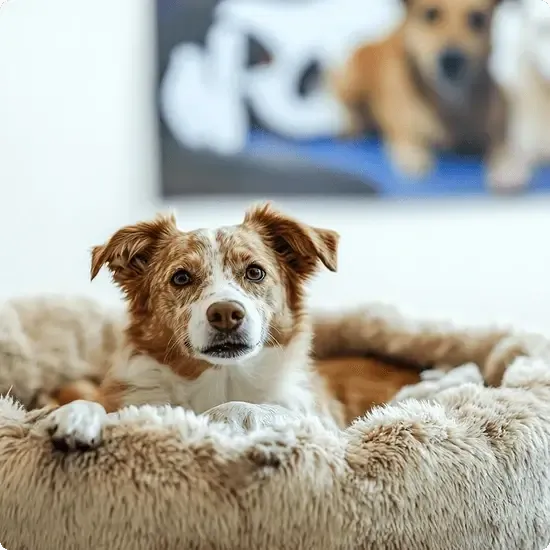
Does your furry friend hide during thunderstorms? Do they become distressed when you leave the house? You’re not alone. Pet anxiety affects millions of dogs and cats, often leaving devoted pet parents feeling helpless as they watch their beloved companions struggle with stress and fear.
Just like humans, our four-legged family members experience anxiety that can manifest in various ways. From excessive barking to destructive behavior, these signs often go unrecognized or are mistaken for bad behavior. Understanding these signals is crucial for providing the support and comfort your pet needs.
This guide will help you identify the key signs of pet anxiety and introduce you to effective solutions, including the innovative MrFluffyFriend calming bed. By learning to recognize anxiety symptoms early, you can take proactive steps to create a more peaceful, happy life for your pet.
Understanding Pet Anxiety: Causes and Impact
Pet anxiety stems from various triggers that can affect our furry companions’ emotional well-being. Dogs and cats react differently to stress-inducing situations, making it crucial to understand these unique responses.
Common Anxiety Triggers in Pets:
- Sudden environmental changes
- Thunderstorms and fireworks
- Separation from family members
- Unfamiliar visitors
- Changes in daily routine
- Moving to a new home
- Traumatic experiences
Dogs vs. Cats: Different Anxiety Responses
Dogs often display their anxiety through:
- Destructive behavior
- Excessive drooling
- Following owners room-to-room
- Urinating inside despite being house-trained
Cats typically show anxiety through:
- Hiding under furniture
- Over-grooming to the point of hair loss
- Marking territory outside the litter box
- Reduced social interaction
Health Impact of Untreated Anxiety
Chronic anxiety can lead to serious physical and behavioral issues:
- Weakened immune system
- Digestive problems
- Increased heart rate
- Depression
- Aggression
- Compulsive behaviors
These effects can create a cycle of stress that impacts both pets and their families. To help alleviate this stress, an anti-anxiety pet bed can provide a safe space for pets to decompress and feel secure during stressful situations. These specially designed beds create a cozy, den-like environment that reduces pet stress, making them ideal for pets struggling with anxiety from thunderstorms, fireworks, or separation.
7 Common Signs Your Pet Has Anxiety
Recognizing anxiety in pets requires careful observation of their behavioral patterns and physical responses. These signs often manifest differently in each animal, but certain key indicators can help identify when your pet is experiencing anxiety.
1. Excessive Vocalization
- Dogs: Persistent barking, whining, or howling when left alone
- Cats: Continuous meowing, yowling, especially during nighttime
- Both may vocalize without apparent external triggers
2. Social Withdrawal
- Avoiding interaction with family members
- Refusing to participate in previously enjoyed activities
- Seeking isolation in unusual places
- Reluctance to leave “safe spaces”
3. Destructive Behaviors
- Chewing furniture, shoes, or household items
- Scratching doors, walls, or carpets
- Digging in inappropriate places
- Destroying toys or bedding
4. Physical Manifestations
- Uncontrolled shaking or trembling
- Excessive panting without physical exertion
- Increased drooling
- Dilated pupils or wide eyes
5. Appetite and Sleep Changes
- Refusing meals or eating less than usual
- Increased or decreased sleeping patterns
- Restlessness during normal sleep times
- Loss of interest in treats or favorite foods
6. Aggressive Tendencies
- Growling at familiar people or animals
- Tucked tail and flattened ears
- Sudden snapping or biting
- Defensive posturing when approached
7. Repetitive Actions
- Constant pacing or circling
- Excessive grooming leading to hair loss
- Frequent yawning or lip licking
- Compulsive sniffing or scratching
These signs often intensify during stressful situations or when anxiety triggers are present. Pets may display multiple symptoms simultaneously, creating a pattern of anxious behavior that affects their daily life and well-being.
How to Calm an Anxious Dog or Cat: Natural Strategies Explained
Creating a calming environment for your anxious pet starts with establishing predictable daily routines. Set regular times for meals, walks, and play sessions to help your pet feel secure and know what to expect each day.
Mental Stimulation Activities:
- Hide treats around the house for your pet to find
- Use puzzle toys during meal times
- Teach new tricks in short, positive training sessions
- Rotate toys weekly to maintain interest
Positive reinforcement training builds your pet’s confidence naturally. Reward calm behaviors with treats, praise, or favorite toys. This encourages your pet to repeat these desired behaviors while creating positive associations with previously stressful situations.
Environmental Enrichment Tips:
- Create designated “safe spaces” with cozy beds and familiar scents
- Use calming music designed specifically for pets
- Install window perches for cats to watch birds
- Provide scratching posts and climbing areas
Natural supplements and pheromone products can complement these behavioral strategies:
- L-theanine supplements promote relaxation
- Chamomile-based treats have mild calming effects
- Synthetic pheromone diffusers mimic natural calming signals
- CBD products (consult your veterinarian first)
Remember to introduce any new calming strategies gradually, allowing your pet time to adjust. A consistent, patient approach helps build trust and reduces anxiety naturally.
Introducing the Calming Bed Concept: What Is It and How Does It Help?
A calming bed is a natural, drug-free way to help pets with anxiety. These specially designed beds mimic the soothing feeling that puppies or kittens experience when they cuddle up with their mothers and siblings.
How Do Calming Beds Work?
Calming beds are designed with raised edges and a soft, plush interior to create a cozy, nest-like space for pets. This design taps into your pet’s instinct to seek out enclosed areas for safety, similar to how wild animals use dens for protection and rest.
Key Features of Calming Beds
- Deep cushioning that adapts to body weight
- Raised rims providing head and neck support
- Self-warming materials that respond to body heat
- Soft, fur-like textures that invite nesting behavior
The Science Behind Calming Beds
The effectiveness of calming beds is supported by research on pressure therapy and sensory comfort. When pets snuggle into these beds, the gentle pressure against their bodies stimulates the release of oxytocin – commonly known as the “feel-good hormone.” This natural response helps lower cortisol levels, reducing stress without medication.
Benefits of Calming Beds
Studies have shown that pets using calming beds experience:
- Less restlessness during thunderstorms
- Reduced pacing behavior
- Improved sleep quality
- Decreased stress reactions to environmental triggers
These beds provide a safe haven for pets when they’re feeling anxious, making them especially useful for animals with mild to moderate anxiety issues.
Why the MrFluffyFriend Calming Bed Stands Out as a Solution
The MrFluffyFriend calming bed incorporates innovative features designed specifically for anxious pets. The bed’s premium memory foam core adapts to your pet’s body shape, providing therapeutic support for joints and muscles. This targeted pressure relief helps release physical tension – a key component of anxiety management.
Distinctive Design Elements:
- Ultra-plush faux fur exterior mimicking a mother’s coat
- Raised rim structure creating a secure, den-like environment
- Non-toxic, hypoallergenic materials safe for sensitive pets
- Water-resistant base protecting against accidents
- Machine washable cover for easy maintenance
Pet parents report significant improvements in their companions’ anxiety symptoms after introducing the MrFluffyFriend bed:
“My rescue dog used to pace all night during thunderstorms. Since getting his MrFluffyFriend bed, he immediately retreats to it when scared and actually stays calm.” – Sarah M.
“My anxious cat went from hiding under furniture to spending hours relaxed in her new bed. The difference in her behavior is remarkable.” – David L.
Making the Most of Your MrFluffyFriend Bed:
- Place the bed in a quiet corner away from high-traffic areas
- Add familiar toys or blankets to enhance comfort
- Reward your pet with treats when they use the bed
- Keep the bed clean and fresh to maintain its appeal
- Consider multiple beds for different rooms
The bed’s effectiveness stems from its thoughtful combination of physical comfort and psychological security. Research shows that pets who feel safe in their resting space display reduced cortisol levels and decreased anxiety-related behaviors.
To make this beneficial product more accessible, exclusive discount codes are available, allowing pet owners to save on these premium anti-anxiety pet beds.
When to Seek Professional Help Beyond Calming Beds
While calming beds like MrFluffyFriend provide significant comfort for pets with mild anxiety, certain behaviors signal the need for professional intervention:
Red Flags for Veterinary Consultation:
- Self-harm or excessive grooming causing wounds
- Severe aggression toward people or other animals
- Complete withdrawal from daily activities
- Persistent house soiling despite proper training
- Destructive behavior causing property damage
- Refusal to eat for extended periods
Professional treatment options often combine behavioral therapy with medical approaches. Veterinary behaviorists can prescribe anti-anxiety medications when necessary, ranging from situational calming aids to daily medications for chronic anxiety.
Behavior Modification Programs
- Counterconditioning: Transforms negative associations into positive ones by pairing anxiety triggers with rewards
- Systematic Desensitization: Gradually exposes pets to anxiety-inducing stimuli at controlled levels
- Response Substitution: Teaches alternative behaviors to replace anxious responses
These professional interventions work best when combined with home solutions like the MrFluffyFriend bed. A qualified veterinarian can create a comprehensive treatment plan tailored to your pet’s specific needs, incorporating both medical and behavioral strategies for optimal results.
Professional guidance becomes essential when anxiety significantly impacts your pet’s quality of life or poses safety risks to themselves or others. Regular veterinary check-ups help monitor progress and adjust treatment strategies as needed.
Conclusion
Understanding and addressing pet anxiety creates a happier, healthier life for our beloved companions. A multi-faceted approach combining knowledge of anxiety signs with practical solutions empowers pet owners to make informed decisions about their pet’s emotional well-being.
The MrFluffyFriend calming bed serves as a valuable tool in your pet anxiety management toolkit. This thoughtfully designed bed provides a safe haven where anxious pets can find comfort and security throughout their day.
Your commitment to learning about pet anxiety demonstrates the deep bond you share with your furry friend. By implementing the strategies discussed – from recognizing early warning signs to creating a supportive environment with tools like the MrFluffyFriend bed – you’re taking meaningful steps toward improving your pet’s quality of life.
Remember: every pet’s journey with anxiety is unique. Stay patient, observant, and responsive to your pet’s needs as you work together toward a calmer, more confident companion.

